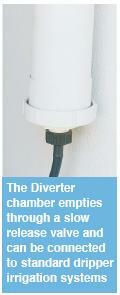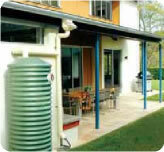Downpipe First Flush Water Diverters improve water quality and reduce tank maintenance by preventing the first flush of water, which may contain roof contaminants, from entering the tank. They help ensure cleaner water is available for use, which protects rainwater pumps and internal household appliances such as clothes washing machines, toilets, hot water systems, etc.
Downpipe First Flush Diverters are designed to be installed at each downpipe that supplies water to the tank. They utilise a dependable ball and seat system – a simple automatic system that does not rely on mechanical parts or manual intervention. As the water level rises in the diverter chamber, the ball floats, and once the chamber is full, the ball rests on a seat inside the diverter chamber preventing any further water from entering the diverter. The subsequent flow of water is then automatically directed along the pipe system to the tank.
Features and Benefits
- Prevents sediment, bird droppings, spiders, insects, mosquito eggs and debris from entering the rainwater tank.
- Improves water quality, and protects pumps and internal appliances.
- Ideal to use in conjunction with a rain head.
- Easy installation, just adds pipe and glue.
- No mechanical parts.
- Low maintenance requirements.
Fitting an appropriately sized First Flush Water Diverter is critical to achieving good quality water. Water Diverters improve water quality, reduce tank maintenance and protect pumps by preventing the first flush of water, which may contain contaminants from the roof, from entering the tank.
When it rains, water slowly builds up in the roof guttering system before it exits through the downpipe. The first flush of water from the roof can contain amounts of bacteria from decomposed insects, skinks, bird and animal droppings and concentrated tannic acid. It may also contain sediments, water-borne heavy metals and chemical residues, all of which are undesirable elements to have in a water storage system.
How much water to divert?
It is important to prevent heavy sediments and other roof pollutants from entering the rainwater tank. It is recommended that the amount of water diverted should be a minimum of 20 litres per 100 square metres of roof area (or 0.2L per m2). In calculating the amount of water to divert, consideration can be given to (1) the surface area of the roof, and (2) the number of pollutants on the roof and gutters.
The following factors can be used as a guide in determining the volume of water to be diverted.
- Pollution Factor For The Roof
- Minimal pollution – Divert 0.5 litres per square metre (open fields, no trees, no bird droppings, clean environment)
- Substantial pollution – Divert 2 litres per square metre (leaves and debris, bird droppings, various animal matter)
- Diversion Factor for a first flush water diverter – m2 Roof Area x Pollution Factor = Litres to be diverted
- Example for a minimal polluted roof of 100m2 – 100 x 0.5 = 50 litres to be diverted
- Example for a heavily polluted roof of 100m2 – 100 x 2 = 200 litres to be diverted
As a rule of thumb, the more water that is diverted the better the quality of water in the tank.
Installation Instructions

- Determine the length of Diverter Chamber #4. Consider as a guide that each:
– 1m of 90mm pipe holds approx. 5.9L of water.
– 1m of 100mm pipe holds approx. 8.8L of water.
Fit the longest length of pipe possible, making sure the Screw Cap #10 is at least 150mm from the ground to allow for removal and cleaning. - Place the ball Seat #9 into Tee Junction #6 ensuring the narrow end of the ball seat points down into the Diverter Chamber #4. Apply glue to the Diverter Chamber #4 and fit up against Ball Seat #9 and hold until the glue sets. (Optional: Use a 45º bend adaptor to allow easier removal of Screw Cap #10). Glue Socket #14 to the bottom end of the Diverter Chamber #4.
- Fix the assembled chamber directly to the wall in the desired position using the Wall Brackets. Note: Optional 90mm Plastic Pipe Bracket set (Product Code: WDAC10) available for under eaves installation.
- Connect a Male & Female (M&F) Elbow #8b (if required) to the Chamber Outlet #8 and connect the downpipe #3. Fit an elbow to the InFeed pipe #2 (if required) and connect to the bottom of the selected rain head.
- Select the appropriate Flow Control Valve #11 and insert it into the Hose Connector #16, making sure the valve is inserted with the side marked “TOP” still showing. Start by using the Control Washer with the smallest gauge hole(lowest number). Try a larger gauge Washer if experiencing blockages. Place the Filter Screen #13 into position from the outside of the Screw Cap #10 and then attach the Hose Connector #16. An extra filter screen that helps stop the Control Valve blocking is available from your local store. Ask for the “Optional Stainless Steel Primary Screen” (Product Code: WDAC02). This filter is fitted in addition to the Plastic Filter Screen #13. To install: after completing step 5, insert the Keeper Ring #1a into Screen Cap #10 and then place the Optional Stainless Steel Primary Screen on top of the Keeper Ring #1a. Proceed to step 6.
- Place the Sealing Ball #5 into the Diverter Chamber #4 and attach the assembled Screw Cap #10 to Socket #14.




